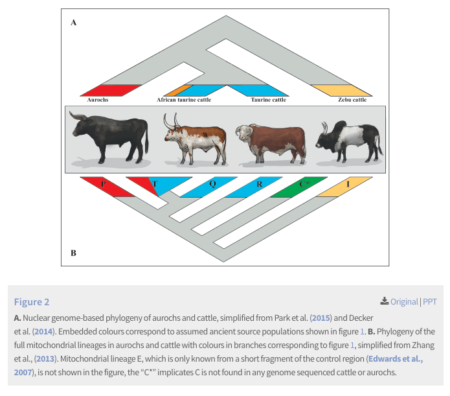- Cryo congress coming.
- Ancient farmers enjoyed a beer…
- …and now we all can.
- Yeah but what’s next in the improvement pipeline?
- CePaCT: The Video.
- Why can’t we all just get along?
- Genetic maps are from Mars, nutrition is from Venus…
- Using markets to teach biodiversity.
- The end of camel herding?
Brainfood: Truffle diversity, Pig diversity, SDMs
- How the truffle got its mate: insights from genetic structure in spontaneous and planted Mediterranean populations of Tuber melanosporum. More outbreeding in plantations, but strong structure still.
- Comparing genetic diversity of pig populations on the US mainland, Pacific Islands and China: Y chromosome evaluation. 16 breeds, 5 haplotypes, 10 breeds with only 1.
- What we use is not what we know: environmental predictors in plant distribution models. Edaphic factors are being ignored. ‘Twas ever thus.
Aurochs redux
A paper just out in Open Quaternary discusses “The Draft Genome of Extinct European Aurochs and its Implications for De-Extinction.” Not to boast about it, but we were onto that five years back.

Brainfood: Wilderness loss, Indian rice breeding, Wild barley, Korean millet, Jute mallow diversity, Wheat yields, Orange cassava
- Catastrophic Declines in Wilderness Areas Undermine Global Environment Targets. 10% of supposedly remote wilderness areas gone since the early 1990s.
- Genetic diversity trend in Indian rice varieties: an analysis using SSR markers. The diversity of rice varieties released in India has been decreasing, but only of late.
- Genotypic and phenotypic changes in wild barley (Hordeum vulgare subsp. spontaneum) during a period of climate change in Jordan. There were changes in climate on one side and phenotype and genotype on the other, but it was difficult to find a connection between the two.
- EST-SSR Based Genetic Diversity and Population Structure among Korean Landraces of Foxtail Millet (Setaria italica L.). As is often the case, there’s no geographic structure, unless there is.
- Domestication of jute mallow (Corchorus olitorius L.): ethnobotany, production constraints and phenomics of local cultivars in Ghana. Let the breeding begin.
- Similar estimates of temperature impacts on global wheat yield by three independent methods. Down by about 5% for a 1°C global temperature increase, no matter how you slice it.
- Genome-wide association mapping of provitamin A carotenoid content in cassava. SNPs associated with carotenoid content in cassava roots found in vicinity of known gene responsible for increase in accumulation of provitamin A carotenoids in cassava roots.
Brainfood: Organic penalty, Rye gaps, Sustainable diet indicators, Wheat evolution
- Commercial Crop Yields Reveal Strengths and Weaknesses for Organic Agriculture in the United States. The headline will be that organic yield is 80% of conventional, but the results are far more nuanced than that suggests.
- Genetic Distinctiveness of Rye In situ Accessions from Portugal Unveils a New Hotspot of Unexplored Genetic Resources. More collecting needed.
- A Consensus Proposal for Nutritional Indicators to Assess the Sustainability of a Healthy Diet: The Mediterranean Diet as a Case Study. 13 indicators of sustainability described, from “Vegetable/animal protein consumption ratios” to “Diet-related morbidity/mortality statistics.”
- Reconciling the evolutionary origin of bread wheat (Triticum aestivum). One slightly changed ancestral subgenome, one much-changed ancestral subgenome, and one weird hybrid subgenome involving the previous two plus another. Basically, we were insanely lucky to get wheat.